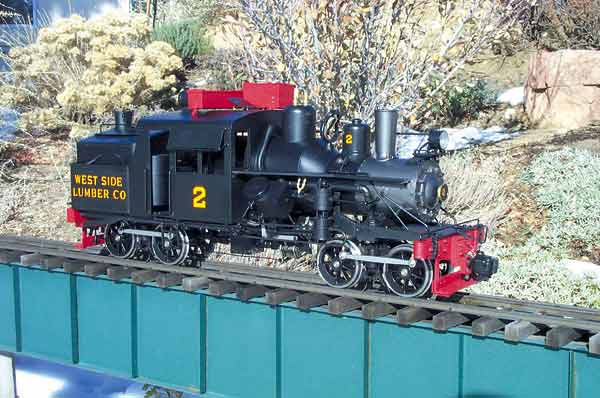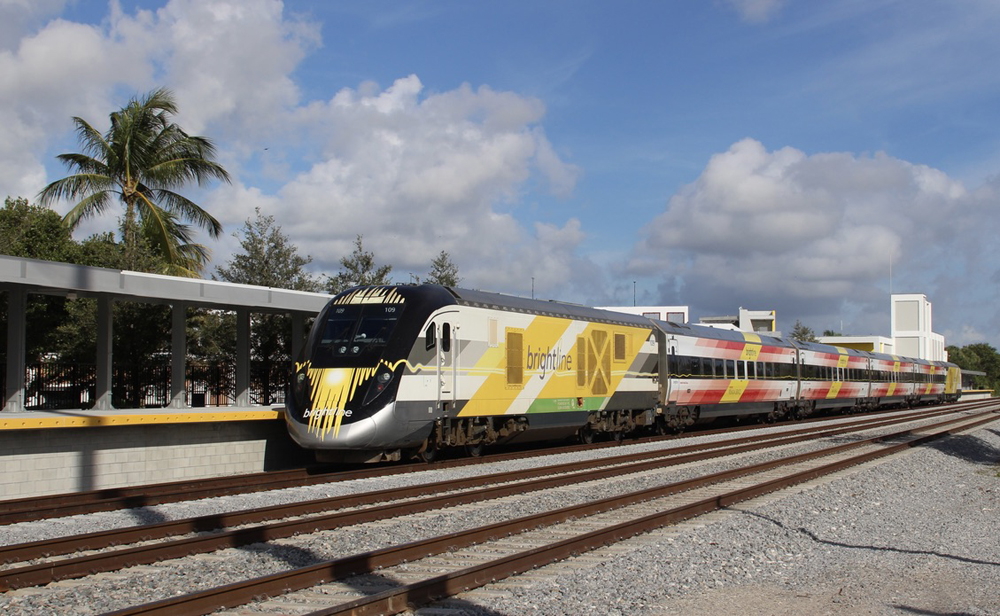Gauge 1, 1:20.3-scale Heisler
Accucraft Trains
31112 San Clemente St
Hayward CA 94544
Price: $2,199
Web site: www.accucraft.com
All metal, painted, electrically powered model of the West Side Lumber Company’s No. 2 Heisler geared locomotive; unit is DCC ready, sound ready, and smoke-unit (not supplied) ready; eight-wheel electrical pickup; instructions provided for maintenance, lubrication, and operation; working, plastic knuckle couplers; sprung trucks; circuit board in oil tank; two on-off switches on circuit board control motor, and sound and lights; circuit diagram supplied; constant voltage, directional lighting. Weight: 12 pounds; minimum radius, 48″; tractive effort, 1 pound, 15 ounces, or the equivalent of around 25 average freight cars; current draw, 1 amp at 24V, full slip. Dimensions: Length, 16 5/8″ over end beams; width, 5″; height over boxes on roof, 7 3/8″. In 1:20.3, this scales out to 28’1″ x 8’5 1/2″ x 12’5 1/2″, respectively
Pros: High quality, highly detailed, well-made model; brass and stainless-steel construction; excellent paint and graphics; high fidelity to prototype; excellent operational characteristics; working couplers; correct scale/gauge combination
Cons: Difficult to disassemble; circuit-board-access instructions do not match the engine; circuit board difficult to access; shiny wheel rims
Accucraft’s model is typical of their production. It is constructed entirely of metal, primarily brass and stainless steel. The engine is powered by a 24V Pitman gearhead motor in the firebox, geared to the driveshaft with helical gears. The driveshaft is connected to the steam engine and the trucks via a total of five universal joints. Outboard axles are powered by bevel gears enclosed in prototypical gearboxes. There is a headlight mounted on the smokebox and a rear light atop the cab. These have 1.5V bulbs in them, controlled by a constant-voltage circuit. The headlight stays on all the time; the backup light comes on only when the engine is reversed. There is also a cab light.
The boiler backhead is pretty well detailed, although there seems to be some missing plumbing and I could not find a throttle lever. Exterior detail is very good, dimensions compare favorably with published drawings, and the model captures the spirit of the prototype. The engine is provided with Accucraft’s plastic, working knuckle couplers. These are held into link-and-pin coupler pockets with removable pins, a nice touch. A circuit board is provided in the oil tank. For access, the instructions tell you to lift out the “coal load,” which is obviously incorrect. The oil tank does not lift out either. A call to the company revealed that you must first remove the water tank (four bolts under the floor) and then remove the oil tank atop it (four more bolts inside the water tank) for access. The wrench supplied with the engine did not fit these bolts. Once the bolts were removed and the back end of the engine disassembled, the circuit board was easily accessible. The board has a terminal strip that is plainly marked and the engine is also supplied with a circuit diagram, so the end user should be able to install a DCC decoder, after-market sound system, and/or smoke unit. A speaker can be mounted inside the water tank.
In operation, the engine is smooth running. There is a fair amount of gear noise, especially at higher speeds, but this may lessen as the gears wear in. Slow-speed operation is superb and the top speed is sedate, reasonable for an engine of this type. Tractive effort is also reasonable and the engine should easily haul up to two dozen average, plastic freight cars–perhaps fewer of AMS’s heavier ones.
In all, this is a well made, smooth running, accurate model of an unusual prototype that deserves the consideration of anyone modeling the West Side Lumber Company or any other logging or industrial railroad.













